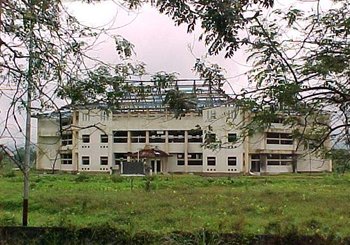Ambon Island
|
|
Ceram_tpc_1967.jpg
AmbonCity2001.JPG
Ambon Island is part of the Maluku Islands of Indonesia. The island has an area of 775 km² (300 sq mi.), and is mountainous, well watered, and fertile.
| Contents |
Ambon City
The main city and seaport is Ambon City (1990 pop. 275,888), which is also the capital of Maluku province. Ambon City has an airport, and is home to the Pattimura University, a state university, and the Indonesian Christian University of Maluku (Universitas Kristen Indonesia Maluku, or UKIM), a private Protestant university. It was the center of recent political / religious violence that displaced tens of thousands of people.
Geography
Ambon Island lies off the south-west coast of the much larger Seram island. It is on the north side of the Banda Sea, part of a chain of volcanic isles that form a circle around the sea. It is 51 km (32 miles) in length, and is of very irregular figure, being almost divided into two. The south-eastern and smaller portion (called Leitimor) is united to the northern (Hitoe) by a neck of land a few yards in breadth. Ambon City lies on the north-west of the peninsula of Leitimor, and has a safe harbor.
The highest mountains, Wawani (1100 m/3609 ft) and Salahutu (1225 m/4020 ft.), have hot springs and solfataras. They are considered to be volcanoes, and the mountains of the neighboring Uliasser islands the remains of volcanoes. Granite and serpentine rocks predominate, but the shores of Amboyna Bay are of chalk, and contain stalactite caves.
The wild areas of Ambon Island are covered in tropical rainforest, part of the Seram rain forests ecoregion, together with neighboring Seram. Seram, Ambon, and most of Maluku are part of Wallacea, the group of Indonesian islands that are separated by deep water from both the Asian and Australian continents, and have never been linked to the continents by land.
As a result of this isolation, Ambon has few indigenous mammals; birds are more abundant. The insect diversity of the island, however, is rich, particularly in butterflies. Seashells are obtained in great numbers and variety. Turtle-shell is also largely exported.
Climate
The average temperature is 80 F., rarely sinking below 72. Rainfall can be heavy, especially after the eastern monsoons, and the island is vulnerable to violent typhoons. The dry season (October to April) is coincident with the period of the west monsoon.
Economy
Maize and sago are the chief crops, which also include breadfruit, sugarcane, coffee, cocoa, pepper and cotton. and hunting and fishing supplement the diet. Nutmeg and cloves, were once the dominant export crops, and are now produced in limited quantities. Copra is also exported. Amboina wood, obtained from a local tree (Pterocarpus indicus), is highly valued for ornamental woodwork, is now mostly grown on Seram.
Demographics
The Ambonese are of mixed Malay-Papuan origin. They are mostly Christians or Muslims. The predominant language of the island is Ambonese Malay, also called Ambonese. It developed as the trade language of central Maluku, and is spoken elsewhere in Maluku as a second language. Bilingualism in Bahasa Indonesia is high around Ambon City.
History
The Portuguese were the first European nation to visit Ambon (1511). They established a factory there in 1521, but did not obtain peaceable possession of it till 1580, and were dispossessed by the Dutch in 1609. About 1615 the British formed a settlement in the island, at Cambello, which they retained until 1623, when it was destroyed by the Dutch,- and frightful tortures inflicted on the unfortunate persons connected with it. In 1654, after many fruitless negotiations, Oliver Cromwell compelled the United Provinces to give the sum of 300,000, together with a small island, as compensation to the descendants of those who suffered in the "Amboyna Massacre." In 1673 the poet John Dryden produced his tragedy Amboyna; or the Cruelties of the Dutch to the English Merchants. In 1796 the British, under Admiral Rainier, captured Ambon, but restored it to the Dutch at the peace of Amiens in 1802. It was retaken by the British in 1810, but once more restored to the Dutch in 1814. Ambon used to be the world center of Clove production; until the nineteenth century, the Dutch prohibited the rearing of the clove-tree in all the other islands subject to their rule, in order to secure the monopoly to Ambon.
During the Dutch period, Ambon City was the seat of the Dutch resident and military commander of the Moluccas. The town was protected by Fort Victoria, and a 1911 encyclopedia characterized it as "a clean little town with wide streets, well planted". The population was divided into two classes orang burger or citizens, and orang negri or villagers, the former being a class of native origin enjoying certain privileges conferred on their ancestors by the old Dutch East India Company. There were also, besides the Dutch, some Arabs, Chinese and a few Portuguese settlers.
Ambon City was the site of a major Dutch military base, which was captured from Allied forces by the Japanese in the Battle of Ambon (1942), during World War II. The battle was followed by the summary execution of more than 300 Allied POWs, in the Laha massacre.
Indonesia declared its independence as a federal republic in 1945. As a result of ethnic and religious tensions, and President Sukarno making Indonesia unitary state, Ambon was the scene of a revolt against the Indonesian government, which resulted in the short-lived Republic of the South Moluccas from 1950 to 1952. Many Ambonese have emigrated to the Netherlands.
External link
- Ambon Information Website (http://www.websitesrcg.com/ambon/)id:Ambon

